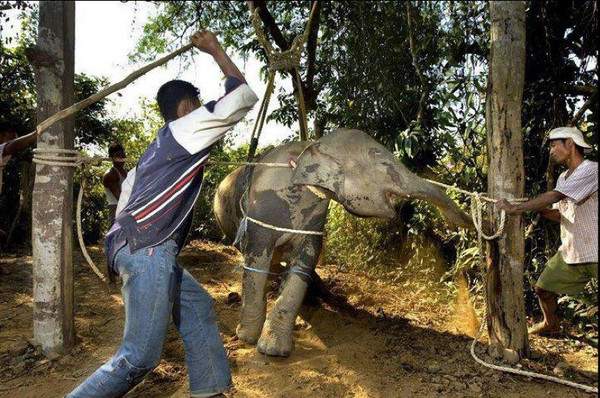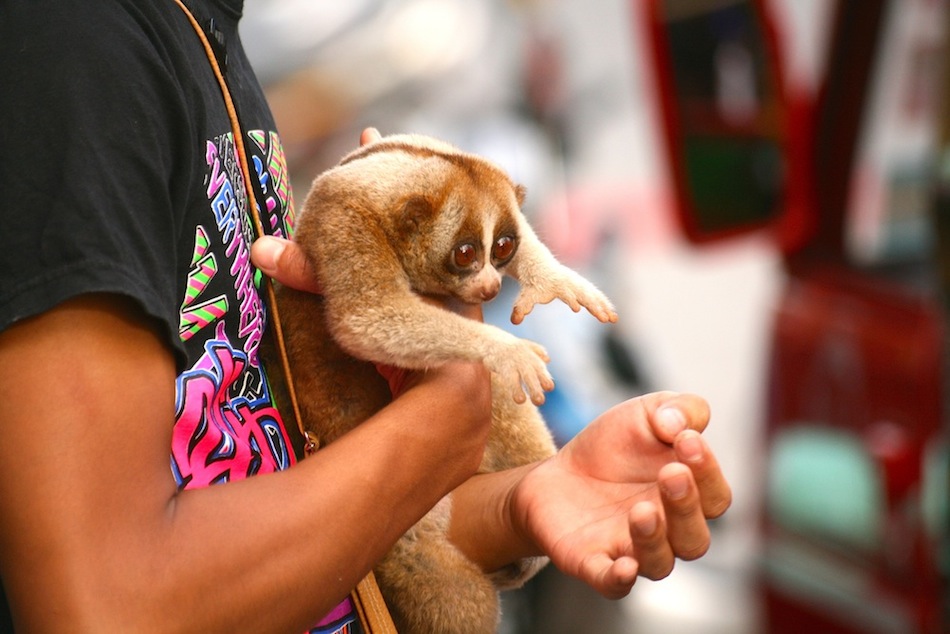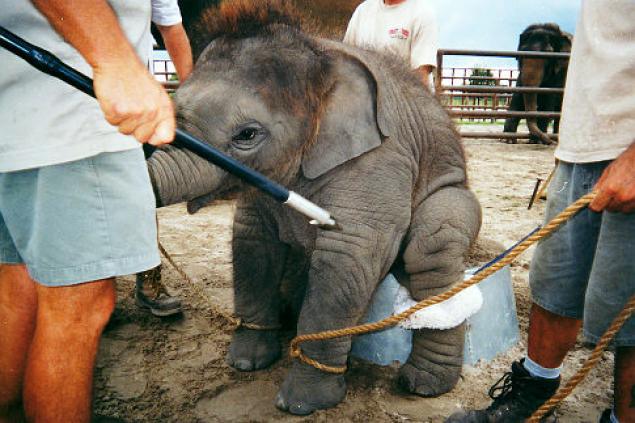A lifetime of misery - travel experiences with animals
Travel experiences that harm animals are under the spotlight like never before. But are you a part of the problem or the solution ?
“It’s five seconds of fun for you, but a lifetime of misery for the animal,” says Philip Mansbridge, CEO of international animal charity Care For The Wild. It’s the controversial Tiger Temples he’s talking about, but the same applies to animal-related activities for tourists around the world, from monkeys forced to play guitars to bike-riding elephants, from captive killer whales to cock fights.
The strange thing is that, as the worldwide controversy over Michelle Bachman’s lion hunt last year and more recently Kendall Jones’ similar ‘trophy’ photo showed, there are a whole lot of animal lovers out there. But, whether they know it or not, what animal-loving travellers choose to do (and pay money to do) when they’re on holiday often feeds into a system that makes animals’ lives a misery and, in some cases, helps wipe out endangered species. “There are a lot of traps people can fall into,” says Mansbridge, “like ‘cruelty masked as culture’. Look at something like bull fighting. If somebody was at home in the UK or the US and there was a bullfight happening, how many people would go? If people were sticking swords in a bull, would you walk on by or would you call the police? People just think ‘different country, different rules’, but your morals should stay the same. Wherever you travel, they should travel with you. That’s the fundamental issue people miss. They think their moral compass should adjust when they go somewhere else, but it shouldn’t.”
“The process is very cruel. It involves chaining elephants up when they’re at a young age, massive beatings with a bull hook, electric cattle prods… It’s done to break the elephant’s spirit.”
Australian tour operator Intrepid recently became the first major company to ban elephant rides on their holidays. Other companies should follow suit, says Mansbridge, as there’s no way for an elephant to be trained without cruelty. “The elephants have had to be ‘broken’. The vast majority are wild and caught, or smuggled in, and then broken. They all have to learn to obey their master and the process is very, very cruel indeed. It involves tying or chaining elephants up when they’re at a young age, then massive beatings with a bull hook, electric cattle prods… It’s done to break the elephant’s spirit, so the elephant does exactly what the master tells it.”
The money elephant rides bring in, often to poor areas, doesn’t justify them, argues Mansbridge. “There are many other ways wildlife can generate income from tourists, like wildlife viewing or elephant parks where you can’t ride the elephant, but they deal with rescued elephants. You can help clear the pens, wash the elephants, that kind of thing. They’re charities and registered NGOs, and they’re the ones people should be putting their money towards.”
Where tourists put their money (and don’t put their money) makes a big difference. The recent documentary Blackfish shone a light on SeaWorld and other marine parks around the world, suggesting big mammals like killer whales shouldn’t be kept in captivity. “People should boycott SeaWorld,” says Mansbridge. “The idea of keeping big sea mammals in pools is fundamentally wrong. An orca whale needs to dive deep, it needs to swim hundreds of miles a day, and no matter how big the swimming pool is or the tank that you put it in, it’s never going to be deep enough or big enough.”
Blackfish made the case that the conditions whales are kept in at SeaWorld may have caused some of the whales to have mental problems and to attack trainers and other people. “If you were put in a space that wasn’t suitable, like if you were locked in your living room, how long before you go crazy?,” Mansbridge asks. “It’s not just the space. It’s also the advanced social structures these animals have, the pods they travel in and the way that they communicate. All that is taken away. An orca lives with its mother and swims with its mother for life. Clearly, if that animal has been separated at a young age, or caught, or even bred, that behaviour can’t be replicated in a tank.”
“SeaWorld’s figures show quite a sharp decline since the release of Blackfish,” he continues, “for the simple reason that people are now more aware of the issues of marine mammals in captivity and they’re making an educated choice.”
Places like SeaWorld are bad not just for whales, but also dolphins, porpoises and other sea creatures, says Mansbridge. And by paying to go, tourists are paying for that system to continue. “I know people have got kids that want to go and see Shamu, and SeaWorld is well marketed and they give a lot of money to conservation, but it’s a commercial business and by paying your entrance fee, giving your money is prolonging it. The other key thing with SeaWorld is the copycats. Other people are capitalising on the thing SeaWorld has created, this excitement about seeing dolphins and marine mammals in captivity, and they don’t have SeaWorld’s standards. They don’t have conservation aims. They don’t have the facilities or money or expertise. What you get is far more substandard. It’s happening a lot in China, Japan and all around Europe, where you’ve got conditions even worse than the conditions you’d get in a facility like SeaWorld.”
Travellers also need to be careful what they buy and eat, from souvenirs made of tiger parts, rhino horn or ivory to shark’s fin soup, which is dangerously depleting shark numbers around the world. All these areas, and elephant rides, marine parks, tiger temples and more, are covered in Care For The Wild’s RIGHT-tourism awareness campaign (RIGHT standing for Responsible, Informed, Guilt-Free and Humane Tourism).
One of the easiest traps to fall into, says Mansbridge, is paying to have your photo taken with animals, without knowing the terrible conditions animals are kept in or cruel ways they’re handled to make that quick souvenir photo possible. “It’s often the people who love these animals that go and pay for the photo, and that’s the strange irony. But people need to understand the backstory. Reports have shown that up to fifty animals die for each one that’s taken from the wild for the entertainment trade. The reason for that is their mothers are killed, or many die in transport, they die before they’ve even made it to somebody’s photo, because of the diet, because of disease…
“If you look at something like the slow loris, which is really popular as a photo prop in Thailand, it’s endangered and it has very specific needs. It’s also nocturnal, so every time you use your flash camera, the animal’s awake during the day and getting flashed in its ultra-sensitive eyes. Its teeth have been pulled out with pliers, because it has venom that it can apply with its teeth. It’s been snatched from the wild, it’s malnourished and being locked up in a cage overnight. Some people think ‘I’m going to pay my five dollars and at least that animal will be looked after’, but it’s not the case. The animal isn’t a pet; it’s a commercial product and when it dies, it will be thrown away, and when it gets ill, it will be thrown away or killed or just left to die. There’s no love and no bond there. The problem with the slow loris is they look so cute and their defence mechanism for when they’re highly stressed is going all floppy and relaxed. People misread that and think ‘He’s happy.’ They think it loves being touched, but the truth is the exact opposite. They’re a victim of their own cuteness.”
Companies work hard to create a false image to attract animal-loving travellers, says Mansbridge. “If you look at something like the Tiger Temple, it’s marketed in a way that’s a lie. It’s marketed as a sanctuary, which it isn’t. It’s marketed as a charity, which it isn’t. It’s marketed as a temple, which it isn’t. People are looking for something on holiday in Thailand and hear about a place that’s a temple that’s run by monks and has these amazing tigers, and it plays into what you want to hear. But people need to be more aware.”
There are other times when common sense should be enough to know animals are being mistreated. But travellers often put their ‘experience’ above the harm being done to animals. “There are cases where people know they’re doing wrong, and put it aside, like with bull fighting. Some people say they know it’s bad, but they just want to experience it to make their own choice… That’s something we need to iron out, because if you know something is bad, if you know black is black and white is white, you don’t need to investigate any further. All you’re doing is prolonging the agony of those animals by paying your money.”
By Graeme Green
17 july 2014
www.curiousanimal.com





